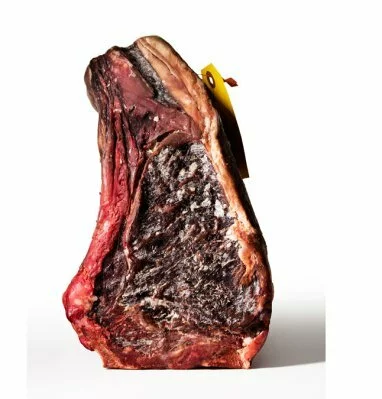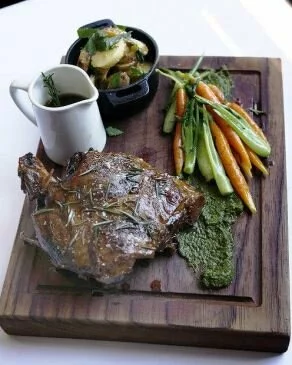Well Hung
Before tackling meat and different foods it seems prudent to look at how it’s stored and the impact that has on the product making the shelves and our plates.
Whilst youths hanging around on street corners irks many a politician it’s certainly for the best if you can afford the time (and money) to allow your meat to hang about a bit. There’s two main ways to hang meat; either wet or dry. Both have their advantages and are widely used across the UK. We’ll start with my least favourite…
- Wet Hanging: the carcass is divided into individual boneless cuts, vacuum packed and stored in a refrigerator for a couple of days. The meat is rapidly hung and doesn’t lose any juices – perfect for retailers wanting to sell as much of the animal as possible (supermarkets love this!). The consumer has a brighter, redder steak with loads of moisture but less flavour. If it’s a good piece of meat, you should be destined for an alright eating experience.
- Dry Hanging: preferred by butchers, good restaurants and top end supermarkets. The carcasses are hung on the bone in a walk in refrigerator. Dry hanging means the meat loses moisture and therefore weight too, this increases the price but it’s worth it if you can afford it! Your dinner plate will be home to a well flavoured, darker, succulent – not wet – piece of meat. If it’s a good piece of meat, an amazing eating experience.
There’s a bit of science behind dry hanging meat which explains why it improves the end product. Through hanging, lactic acid forms in the muscle helps to tenderise it and more importantly natural enzymes get to work. Man do they do some fantastic work!
Sweet, tender flavour
Enzymes break down proteins into amino acids, some of which form Umami(umami is one of the five basic tastes and is Japanes
e for Good Taste or Good Flavour). Henceforth the development of umami within the meat gives it a brilliant deeper flavour.
The small amount of carbohydrates stored within meat are converted into sugars, giving a sweeter flavour and the enzymes also weaken connective tissue surrounding protein strands to give more tender meat. Like I said those enzymes do a great job.
7, 14, 21, 28, too long?
There’s huge debate as to how long meat should be hung. Firstly I’ll say that personally I won’t eat meat that isn’t hung, it’s such a simple process but adds so much. Plus, you’ve got to give those little critters the enzymes enough time to do their magic. For me: beef, lamb and game have to be hung, poultry is best served fresh and pork somewhere in-between. You might disagree?!
Beef roasting and grilling joints such as sirloin, topside or rump should be hung for either 21 or 28 days for optimum meat quality, after twenty eight days little additional benefit is gained from hanging longer.
Bone in lamb or mutton cuts should be hung for 7 days and bones for 10 days, as with beef after 15 days little gain is had from hanging for longer.
Hanging game is slightly more subjective because of its bigger, stronger flavours but as per lamb or mutton a good 7 days in a refrigerator will only improve its eating qualities. For any type of meat there’s no need to hang meat destined for stew or mincing.
For both beef and lamb I said that hanging over 28 and 15 days respectively won’t give any additional benefits to the quality of the meat. It will however change it. There’s many “chic” restaurants hanging beef for 52, 90 or even 180 days – in reality this is as much showmanship and a gimmick as anything. Hanging for this long will change the flavour but doesn’t necessarily improve it.
“Stop! Before you finish you said that hanging meat dries it out. Surely this isn’t good?”
Yes it is! Drying out meat increases the fat to muscle ratio. When you cook meat, any water based juice evaporates and is lost from the meal whereas the fats melt into the muscles fibres and give such sought after succulence. Slightly dried muscle fibres also loses their ability to hold onto moisture and therefore release more when you eat them. Pretty nifty and to put in context when I say “dry out” think less Arabian Desert and more washing line on a sunny Cornish afternoon*.
My departing words to you all are: Do buy meat that’s been hung, it will improve the meat and your meal. Do pay attention to the hanging time; 21 to 28 days for beef, 7 or 15 for lamb and mutton and 7 to 14 days for game are best – after that you’re on your own. Finally, Do try different hanging times within the optimum brackets, you might just notice a difference.
Hang loose! GB
*Don’t hang your steak on a washing line, whether you’re in Cornwall or not.
I was going to add some links of companies who could send you meat mail order but then I changed my mind. Google (I’ve even linked it to make your life easier) your local butchers and go for a drive on Saturday morning. See it, drool just a little bit, then buy it!
Please find more blogs on my website http://garethbarlow.wordpress.com











 Saving...
Saving...
Add a comment
You must be logged in to post a comment.